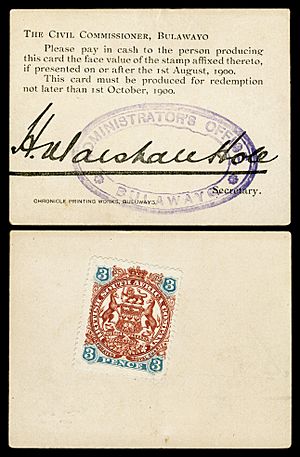Hugh Marshall Hole facts for kids
Hugh Marshall Hole (born May 16, 1865 – died May 18, 1941) was an important English pioneer, government official, and writer. He is most famous for creating a special type of money known as "Marshall Hole currency." He was also a Lieutenant-Colonel and received an award called the CMG, which stands for Companion of the Order of St Michael and St George.
Contents
Early Life and Education
Hugh Marshall Hole was born in a town called Tiverton in Devon, England. He went to school at Blundell's School. Later, he studied at Balliol College at Oxford University, where he won a special scholarship called the Newte exhibition.
Working in Africa
In 1889, Marshall Hole traveled to Cape Colony in Southern Africa. There, he met a very powerful businessman and politician named Cecil Rhodes in Kimberley. Rhodes was impressed by Marshall Hole and offered him an important job.
First Clerk for a New Company
Marshall Hole became the first clerk for the British South Africa Company. This was a new company that was set up to explore and control land in Southern Africa. In 1891, he became the private secretary to Sir Starr Jameson. Sir Starr Jameson was soon made the Administrator, or leader, of the company's territories in a region called Mashonaland.
Important Government Roles
Marshall Hole held many other important jobs during his time in Africa:
- He was the Secretary for Matabeleland, another region.
- He served as the Civil Commissioner of Bulawayo, which meant he was a top government official in the city.
- He became the Chief Secretary of Southern Rhodesia, a large area controlled by the British.
- He was the Chief Native Title Commissioner for Matabeleland, dealing with land rights for local people.
- He even became the Administrator of North West Rhodesia, another British territory.
Cecil Rhodes really liked Marshall Hole. In 1901, Rhodes sent him on trips to Arabia. The goal was to find ways to bring workers from Arabia to Southern Rhodesia. Marshall Hole also took charge of all the plans for Cecil Rhodes's burial in the Matopo Hills in 1902.
Retirement and War Service
Marshall Hole retired from his government work in 1913. When World War I started, he joined the army with The Norfolk Regiment. He was recognized for his brave actions during the war and retired from the army in 1919.
The Marshall Hole Currency
Marshall Hole is most famous for creating "Marshall Hole currency" in Bulawayo in 1900. This happened during the Anglo-Boer War, which was a conflict in Southern Africa.
Why Emergency Money Was Needed
During the war, there was a big problem: not enough small coins were available in Rhodesia. People needed a way to buy everyday things. Marshall Hole, who was the Government Secretary for Matabeleland and Civil Commissioner of Bulawayo at the time, came up with a clever idea.
He allowed small cards to be used as money. These cards had a British South Africa Company postage stamp on the front. On the back, they had an official signature stamped by hand. These special cards were used as emergency money from August 1, 1900, until they were stopped on October 1, 1900.
How the Currency Worked
A writer named Smith (in 1967) explained that stamps worth about £20,000 were used for this currency. When the cards were no longer used, it was found that about £1,000 worth of them were still out there. This £1,000 became a clear profit for the government. It also made up for the jokes and doubts people had when Marshall Hole first suggested his idea.
The currency cards came in different values, like 2 pence, 3 pence, 4 pence, 6 pence, 1 shilling, 2 shillings, 2 shillings and 6 pence, 4 shillings, 5 shillings, and 10 shillings. They had two types of official stamps to show they were real. One stamp said ADMINISTRATOR'S OFFICE * BULAWAYO. The other simply said ADMINISTRATOR'S OFFICE. These stamps were put on the cards at Marshall Hole's office.


